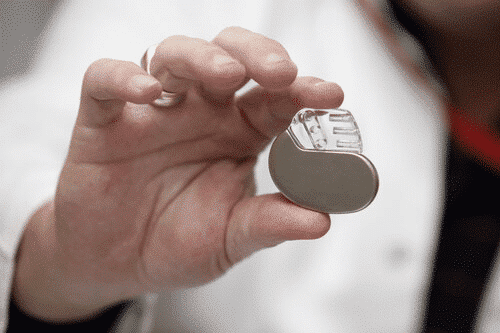Do pacemakers aid in AFib management and how does a pacemaker help AFib? The simple answer is they can be beneficial, especially when intermittent slow heart rate complicates your AFib treatment. This article strips down the complexities to explain how pacemakers relate to AFib treatment, their potential benefits, and what changes to anticipate when considering a pacemaker for AFib.
Key Takeaways
- Pacemakers play a crucial role in managing Atrial Fibrillation (AFib) by ensuring a regular heart rate, especially in patients who experience bradycardia or have conditions necessitating pacing such as complete heart block or AV node ablation.
- Patients with AFib and pacemakers require regular cardiology follow-ups to ensure optimal device function and management of their condition, including medication adherence and monitoring for side effects.
- Combining AV node ablation with pacemaker implantation may be beneficial for patients with treatment-resistant AFib, as it allows the pacemaker to control the heart rhythm while preventing rapid heart racing and potentially reducing medication requirements.
Exploring Atrial Fibrillation and Pacemakers

When it comes to dealing with irregular heartbeats, pacemakers have proven to be a reliable ally. Their role becomes crucial in managing a heart condition known as atrial fibrillation. This condition affects the heart rate and rhythm, which can be worrisome if not addressed promptly.
To understand why pacemakers are commonly recommended for AFib patients, let’s first delve into what AFib is and how a pacemaker works.
What is Atrial Fibrillation?
Atrial fibrillation, often abbreviated as AFib, is a condition where the heart beats in an irregular, often rapid rhythm. It results from chaotic electrical signals in the heart’s upper chambers (atria), causing them to beat out of sync with the lower chambers (ventricles). This arrhythmia can lead to a wide array of symptoms, including:
- palpitations
- chest pain
- fatigue
- shortness of breath
- dizziness
- lightheadedness
- fainting
If you experience any of these symptoms, it is important to consult with a healthcare professional for proper diagnosis and treatment.
AFib can take multiple forms, each requiring a specific set of management strategies. The risk of AFib increases with age and can be influenced by several factors, including lifestyle habits and other heart conditions.
How Does a Pacemaker Work?

A pacemaker is a small device designed to regulate the heartbeat. It sends small electrical signals to the heart, ensuring that it beats at a regular rate, thus helping to alleviate AFib symptoms. Most pacemakers comprise of a generator and wires, which are placed inside the heart.
There are various types of pacemakers, including:
- Traditional ones placed transvenously that include a generator and wires.
- Those with electrodes placed directly onto the heart’s surface
- Small transcatheter placed pacemakers are ones where the generator and electrodes are combined in one small device
Despite their complex function, pacemakers are quite small, lightweight, and generally well-tolerated by the body.
Read more about the pacemaker implantation procedure here.
Can Pacemakers Treat AFib Symptoms?
The role of pacemakers in managing AFib symptoms is significant. Not only can pacemakers help alleviate symptoms when they occur, but they also provide valuable information about the heart rate during treatment adjustments.
The Intersection of AFib and Bradycardia
AFib doesn’t always walk alone; it sometimes accompanies a condition called bradycardia, where the heart rate is slower than normal. This can lead to symptoms like fatigue, dizziness, and shortness of breath. In severe cases a patient may also pass out due to bradycardia.
A pacemaker ensures that the heart does not beat too slowly and helping to manage the symptoms of bradycardia.
Let’s take a closer look at bradycardia and when a pacemaker might be recommended.
Understanding Bradycardia in AFib Patients
Bradycardia, characterized by a slower than normal heart rate, is a significant concern in AFib patients as it can exacerbate symptoms of AFib or make management of AFib symptoms difficult. The symptoms of bradycardia in AFib patients include lightheadedness, syncope, and fatigue.
A challenge lies in treating AFib patients with bradycardia because medications that control AFib might worsen bradycardia. This is where pacemaker therapy comes in, helping to alleviate these symptoms and improve the patient’s quality of life.
When is a Pacemaker Recommended?
A pacemaker is typically recommended for AFib patients experiencing significant symptoms of bradycardia, such as fainting, dizziness, or fatigue, which can’t be managed by other means. It may also be necessary for patients with conditions indicating an absolute need for pacing, such as advanced atrioventricular block or complete heart block.
Even if a patient’s slow heart rate is not causing clear symptoms, a pacemaker might be recommended to mitigate the risk of potential symptomatic bradycardia. In addition, symptoms of AFib may also be better controlled with the aid of a pacemaker.
Adjusting to Life with a Pacemaker

Getting a pacemaker can feel like a life-altering event. Yet, with good care and lifestyle adjustments, it’s possible to continue living an active life. After the pacemaker is implanted, there are certain things that patients need to keep in mind to ensure the device functions optimally and that their health is not compromised.
Daily Activities and Lifestyle Changes
The journey of living with a pacemaker necessitates certain lifestyle changes. Here are some important considerations:
- Stay active, but limit vigorous activity and heavy lifting for the first few weeks after pacemaker implantation to ensure proper healing at the incision site.
- Eat a heart-healthy diet to support overall heart health.
- Adhere to medication schedules as prescribed by your doctor.
By following these guidelines at the right pace, you can maintain a healthy lifestyle while living with a pacemaker.
It’s all about finding the right balance and making choices that improve cardiovascular health and reduce the severity of AFib symptoms.
Interactions with Electrical Devices and Metal Detectors
While pacemakers are designed to withstand interference from most everyday electronics, they can be affected by certain devices. Keeping the pacemaker at least 6 inches away from potential interferers and minimizing contact with electrical devices or strong magnetic fields is essential.
In general, most household electronics such as a microwave or cell phone are unlikely to cause any significant interactions with a pacemaker.
At security checkpoints, metal detectors may set off an alarm due to the pacemaker, but body scanners are safe. In such situations, patients can present their pacemaker ID card and request a hand search instead.
AV Node Ablation: A Common Companion Procedure to Pacemaker Implantation for AFib Patients
When it comes to treating AFib, sometimes a pacemaker may not be enough. In such cases, additional procedures such as AV node ablation may be recommended. This procedure treats AFib by destroying the atrioventricular node, the heart’s electrical bridge between the atria and ventricles, through the application of radiofrequency energy.
But why combine AV node ablation with a pacemaker, and what does this procedure entail?
What is AV Node Ablation?
AV node ablation is a catheter-based procedure that uses radiofrequency energy to destroy the atrioventricular node. Essentially, it creates a ‘block’ that prevents electrical short-circuits from reaching the ventricles, allowing the pacemaker to have complete control over heart rhythm. The procedure is performed in a cardiac catheter laboratory, where a small burn is delivered via a catheter to the AV node, disrupting the heart’s signaling connection and preventing irregular heartbeats.
Why Combine AV Node Ablation with a Pacemaker?
The combination of AV node ablation with pacemaker implantation offers several benefits:
- Prevents rapid heart racing
- Leads to a regular heart rhythm
- Reduces the number of medications needed
- Can increase ejection fraction, improving heart failure symptoms for some patients.
After AV node ablation, the pacemaker is required to regulate the heart’s ventricular rhythm, as the natural conduction pathway is disrupted.
Since patients are dependent on a pacemaker after an AV node ablation, this combined treatment is often reserved for patients whose atrial fibrillation is resistant to other treatments.
Evaluating the Risks and Benefits of Pacemaker Therapy for AFib
While pacemakers offer substantial benefits, it’s important to understand the risks and benefits of this therapy for AFib. Pacemakers can monitor heart activity, assist in the adjustment of medications, and ensure safe conduct of medical procedures. However, pacemaker implantation does carry a small chance of complications.
Let’s dig deeper into these potential complications and weigh the pros and cons of this therapy among other treatment options.
Potential Complications from Pacemaker Implantation
Pacemaker implantation, though common, is not without risks. Potential complications include infection, blood clots, tissue scarring, pacemaker or wire displacement, pacemaker malfunction. Signs of pacemaker malfunction or complications include swollen ankles, difficulty breathing, dizziness, or fainting, necessitating immediate medical attention.
Patients must also be vigilant for infection symptoms at the pacemaker site, such as fever, chills, and pain or redness, even months after surgery. Regular monitoring and check-ups are vital to prevent complications and ensure the device is functioning properly.
Weighing the Pros and Cons
While implanting a pacemaker presents certain risks, it’s important to weigh these against the potential benefits. Patients with pacemakers have been shown to have an impressive cumulative survival rate over a ten-year period, with some studies reporting rates as high as 70%.
Some patients who received dual-chamber pacemakers had a higher cumulative survival rate compared to those with single-chamber pacemakers over a ten-year period.
These findings emphasize the importance of personalized treatment plans in managing AFib. In addition, not every pacemaker is the same, so it is up to your doctor to decide which pacemaker is the best in your situation or treatment plan.
Beyond Pacemakers: Comprehensive AFib Management
While pacemakers play a crucial role in managing AFib, it’s essential to adopt a comprehensive approach to AFib management. This includes the use of medications to prevent and treat blood clots, control heart rate and regulate rhythm, and lifestyle modifications such as regular exercise, a balanced diet, weight loss, and cessation of smoking and excessive alcohol.
Let’s explore the role of medications in AFib treatment and why regular cardiology follow-ups are important.
Medications and Their Role in AFib Treatment
Medications are a cornerstone in AFib treatment. Anti-coagulation therapy with medications such as warfarin or direct-acting oral anticoagulants (like Eliquis) is critical to prevent blood clots and reduce the risk of stroke. Rate control medications like beta blockers and calcium channel blockers are key to maintaining a normal heart rate during AFib episodes to reduce symptoms.
In addition to these, anti-arrhythmic drugs play a role in managing the condition and promoting normal sinus rhythm. Adherence to medication schedules and regular monitoring are necessary to check for side effects and ensure appropriate dosing.
The Importance of Cardiology Follow-Up
Regular follow-ups with a cardiologist are crucial for patients with AFib and pacemakers. These regular check-ups help monitor the pacemaker’s function and manage AFib symptoms effectively. Continuous monitoring for atrial fibrillation is key as it can uncover significant amounts of AF activity, which is vital for assessing treatment efficacy and stroke risk.
Patients should be proactive in noting any unusual patterns or changes in their pacemaker’s performance and report these to their doctor promptly.
Personal Stories: Living with AFib and a Pacemaker
Behind every pacemaker is a story of resilience and adaptation. It’s through these personal narratives that we gain a deeper understanding of what it truly means to live with AFib and a pacemaker. These stories reveal the physical, financial, and social challenges that come with pacemakers, but they also highlight the comfort, reassurance, and new lease on life that these devices can provide.
Managing Expectations: The First Year After Surgery
The first year after pacemaker surgery is a crucial period of adjustment. From returning home post-surgery to resuming work and dealing with physical problems like pain and fatigue, patients experience a whirlwind of changes.
Yet, amidst these challenges, patients frequently find ways to cope, adapt, and embrace their new normal with courage and resilience.
Long-Term Adaptation: Finding Your New Normal
Living with a pacemaker is a lifelong commitment, requiring long-term adaptation and lifestyle changes. Patients may need to modify their work, physical activities, and social interactions to accommodate the device and reduce risks of complications.
Over time, occasional pacemaker adjustments help fine-tune the response to AFib and ensure comfort and optimal cardiac function. Despite the challenges, most patients express satisfaction with their pacemakers, appreciating the comfort and reassurance it offers, with improved AFib symptoms.
Summary
Our journey through the world of atrial fibrillation and pacemakers has revealed a complex yet fascinating interplay between these two. From understanding what AFib is and how pacemakers work, to exploring the intersection of AFib and bradycardia, we have seen how pacemakers can be a vital tool in managing AFib. But the journey doesn’t end with a pacemaker. Comprehensive AFib management, including medication adherence, lifestyle modifications, regular cardiology follow-ups, and a positive mindset, is equally crucial. Remember, it’s not just about living with AFib and a pacemaker; it’s about thriving despite them.
Frequently Asked Questions
Does a pacemaker help correct AFib?
If you have atrial fibrillation and your heart is beating too slowly, your doctor may recommend a pacemaker to help your heart beat regularly. A pacemaker can send electrical signals to regulate your heart rate and alleviate AFib symptoms.
Is ablation or pacemaker better for AFib?
In many patients with paroxysmal AF symptoms, an AF ablation appears to be superior to a strategy of pacemaker plus medications. However, there is no one size fits all answer to this question. There are many factors to consider in an optimal treatment plan, only your doctor can decide which procedure is best for you.
Can you still have AFib with a pacemaker?
Yes, even with a pacemaker, you can still have atrial fibrillation, which increases the risk of stroke due to potential blood clots.
Does a Pacemaker Cure AFib?
While a pacemaker can significantly manage the symptoms associated with Atrial Fibrillation (AFib), it does not cure the condition. Pacemakers are designed to ensure that the heart maintains a regular rhythm, especially in cases where AFib is accompanied by bradycardia (a slow heart rate). The device can correct slow heart rhythms but does not directly address the erratic electrical impulses that characterize AFib.
Therefore, while a pacemaker can improve quality of life and reduce AFib symptoms, it is part of a broader management strategy that may include medications, lifestyle changes, and other procedures.
Do I Still Need Blood Thinners for AFib if I Get a Pacemaker?
Even after receiving a pacemaker, patients with AFib may still require blood thinners. The pacemaker is designed to maintain a regular heart rate and does not prevent the formation of blood clots in the atria, which is a common risk associated with AFib. Blood thinners, such as warfarin or direct-acting oral anticoagulants (like Eliquis or Xarelto), are typically prescribed to reduce the risk of stroke by preventing clot formation.
It’s important to follow your healthcare provider’s recommendations regarding blood thinner therapy, even after a pacemaker has been implanted.
The Best Atrial Fibrillation Book
Your Complete Guide To AFib: The Essential Manual For Every Patient With Atrial Fibrillation
$15.95 (as of May 27, 2025 13:40 GMT -06:00 - More infoProduct prices and availability are accurate as of the date/time indicated and are subject to change. Any price and availability information displayed on [relevant Amazon Site(s), as applicable] at the time of purchase will apply to the purchase of this product.) The A to Z guide on everything you need to know about atrial fibrillation. Written by AFib expert Dr. Percy Morales MD. Over 120 pages of essential information on medications, procedures, and lifestyles modifications for AFib. Easy to read for every patient.
Shop AFib Products on Amazon
KardiaMobile 6-Lead Personal EKG Monitor – Six Views of The Heart – Detects AFib and Irregular Arrhythmias – Instant Results in 30 Seconds – Works with Most Smartphones - FSA/HSA Eligible
13% Off
KardiaMobile 1-Lead Personal EKG Monitor – Record EKGs at Home – Detects AFib and Irregular Arrhythmias – Instant Results in 30 Seconds – Easy to Use – Works with Most Smartphones - FSA/HSA Eligible
$79.00 (as of May 27, 2025 13:40 GMT -06:00 - More infoProduct prices and availability are accurate as of the date/time indicated and are subject to change. Any price and availability information displayed on [relevant Amazon Site(s), as applicable] at the time of purchase will apply to the purchase of this product.)
Apple Watch Series 9 [GPS 41mm] Smartwatch with Storm Blue Aluminum Case with Silver Sport Band M/L. Fitness Tracker, Blood Oxygen & ECG Apps, Always-On Retina Display
(as of May 27, 2025 06:39 GMT -06:00 - More infoProduct prices and availability are accurate as of the date/time indicated and are subject to change. Any price and availability information displayed on [relevant Amazon Site(s), as applicable] at the time of purchase will apply to the purchase of this product.)
Fitbit Sense 2 Advanced Health and Fitness Smartwatch with Tools to Manage Stress and Sleep, ECG App, SpO2, 24/7 Heart Rate and GPS, Shadow Grey/Graphite, One Size (S & L Bands Included)

OMRON 2-in-1 Upper Arm Blood Pressure Monitor & 1-Lead EKG Monitor - Clinically Validated Blood Pressure Arm Cuff & Machine - Use OMRON Connect App
17% Off
Samsung Galaxy Watch 6 44mm Bluetooth Smartwatch, Fitness Tracker, Personalized HR Zones, Advanced Sleep Coaching, Heart Monitor, BIA Sensor, Health Wellness Insights, Big Screen, US Version, Graphite
51% Off $329.99 (as of May 27, 2025 19:00 GMT -06:00 - More infoProduct prices and availability are accurate as of the date/time indicated and are subject to change. Any price and availability information displayed on [relevant Amazon Site(s), as applicable] at the time of purchase will apply to the purchase of this product.)
Natural Rhythm Triple Calm Magnesium 150 mg - 120 Capsules – Magnesium Complex Compound Supplement with Magnesium Glycinate, Malate, and Taurate. Calming Blend for Promoting Rest and Relaxation.
$20.77 ($0.17 / Count) (as of May 27, 2025 15:17 GMT -06:00 - More infoProduct prices and availability are accurate as of the date/time indicated and are subject to change. Any price and availability information displayed on [relevant Amazon Site(s), as applicable] at the time of purchase will apply to the purchase of this product.)
Pure Encapsulations Magnesium (Glycinate) - Supplement to Support Stress Relief, Sleep, Heart Health, Nerves, Muscles, and Metabolism* - with Magnesium Glycinate - 180 Capsules
$44.60 ($0.25 / Count) (as of May 27, 2025 06:44 GMT -06:00 - More infoProduct prices and availability are accurate as of the date/time indicated and are subject to change. Any price and availability information displayed on [relevant Amazon Site(s), as applicable] at the time of purchase will apply to the purchase of this product.)














![Apple Watch Series 9 [GPS 41mm] Smartwatch with Storm Blue Aluminum Case with Silver Sport Band M/L. Fitness Tracker, Blood Oxygen & ECG Apps, Always-On Retina Display #1](https://m.media-amazon.com/images/I/311xwtp4mFL._SL100_.jpg)
![Apple Watch Series 9 [GPS 41mm] Smartwatch with Storm Blue Aluminum Case with Silver Sport Band M/L. Fitness Tracker, Blood Oxygen & ECG Apps, Always-On Retina Display #2](https://m.media-amazon.com/images/I/41j+8AaUGsL._SL100_.jpg)
![Apple Watch Series 9 [GPS 41mm] Smartwatch with Storm Blue Aluminum Case with Silver Sport Band M/L. Fitness Tracker, Blood Oxygen & ECG Apps, Always-On Retina Display #3](https://m.media-amazon.com/images/I/41jIyxZitnL._SL100_.jpg)
![Apple Watch Series 9 [GPS 41mm] Smartwatch with Storm Blue Aluminum Case with Silver Sport Band M/L. Fitness Tracker, Blood Oxygen & ECG Apps, Always-On Retina Display #4](https://m.media-amazon.com/images/I/41IpNJERjCL._SL100_.jpg)
![Apple Watch Series 9 [GPS 41mm] Smartwatch with Storm Blue Aluminum Case with Silver Sport Band M/L. Fitness Tracker, Blood Oxygen & ECG Apps, Always-On Retina Display #5](https://m.media-amazon.com/images/I/31o17yhfYpL._SL100_.jpg)






































